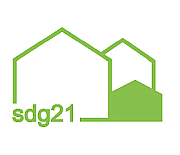Inclusion in the web database
The decision on the inclusion of projects in the directory and their evaluation lies with Holger Wolpensinger, who draws on his experience and research during his more than 20 years of working on the subject of sustainable construction. More information about the person can be found on the web at: https://greenup.one/wolpensinger
Clues
- Settlements
- >1 house, >20 WE
- Topics: at least 3 implemented sustainable building topics or one particularly innovative component or concept.
Examples: http://sdg21.eu/siedlungen
- Quarters
- Urban quarters in sustainable construction, as mixed as possible in terms of use and / or social mix, are still not a matter of course, although they have been the official guiding principle since 2003 (New Charter of Athens, which unfortunately hardly anyone knows) on the part of planning associations and since 2007 (Leipzig Charter on Sustainable European Cities) on the part of urban planning and building policy in Europe.
- > 20 WE
Examples: http://sdg21.eu/quartiere respectively www.quartiere.net
- Building
- Individual buildings are not the focus of the sdg21.web database. Therefore, they only find their way into the collection if they are prototypes for a new development in sustainable building. Especially if these concepts or technologies do not yet exist in a settlement or neighbourhood.
Examples: http://sdg21.eu/gebaeude
- Individual buildings are not the focus of the sdg21.web database. Therefore, they only find their way into the collection if they are prototypes for a new development in sustainable building. Especially if these concepts or technologies do not yet exist in a settlement or neighbourhood.
- Projects in development
- Initiatives require a certain level of planning (financing is in place, land has been purchased and marketing is imminent or underway).
- Projects that are monothematically optimised for a sustainable building theme are only included in exceptional cases.
Which criteria should a settlement fulfil in order to be included in the sdg21.web database?
In order to show the whole range of ecological and sustainable building, settlements are included which have realised very far-reaching ecological and social principles (e.g. the Moorwiesensiedlung in Kiel-Hassee), but also projects with partly only one ecological aspect (e.g. some "Solar local heating projects"). At present, this can only be derived from the descriptions. A qualitative evaluation, which was developed and carried out in the context of an upper school seminar at the University of Karlsruhe, has so far been carried out for the data available on this Website listed projects. The aim was to identify the strengths and weaknesses of the individual projects. However, the evaluation effort is large, which is why only a few projects have been evaluated so far.
Independent website
The website is created voluntarily and without financial sponsors to the best of our knowledge. Historical and innovative aspects or underlying ideas play a role. If you notice any errors, please send me a short message (Mail).
The Definitions of the terms 'ecological building', 'ecology' and 'sustainability' helps to grasp the topic more concretely and simplifies access to the subject.
Mission Statement
My definition of "sustainable or ecological settlement" is based on:
- an extensive library and archive, with "grey literature" and data collection (many pdfs and information are often no longer available on the short-lived internet)
- Visits to about half of the settlements and neighbourhoods listed on sdg21 in Germany and further projects in Switzerland, Austria, Holland, Denmark and Sweden.
- Visit and organisation of congresses, conferences, environmental and construction fairs, as well as seminars, excursions and lecture series on the subject of
- Full-time employment with ecological and sustainable building methods since 1988
- Print Publications since 1996 and Lectures since 1995
- Voluntary work and board activities in associations and projects, some of which are nationwide, that are committed to sustainable building and housing.
Implementation of the experience in draft
A summary of the experiences and findings from the more than 200 ecological building and settlement projects that I have become acquainted with over the years are reflected in particular in the design of the Settlement Nancystrasse again. It was created as a free urban design by Dr. Michael Peterek at the Chair of Urban Planning and Design at the University of Karlsruhe.
The relevance and effectiveness of individual measures have been mathematically tested and demonstrated in a life cycle assessment for this draft. Compared to a standard variant with federal averages, PEI and CO2 emissions could be reduced by 80%. With today's technologies of plus-energy settlements and neighbourhoodsCO2-neutral projects are possible (note: 2020).
=> Diploma thesis Holger Wolpensinger (2002)
